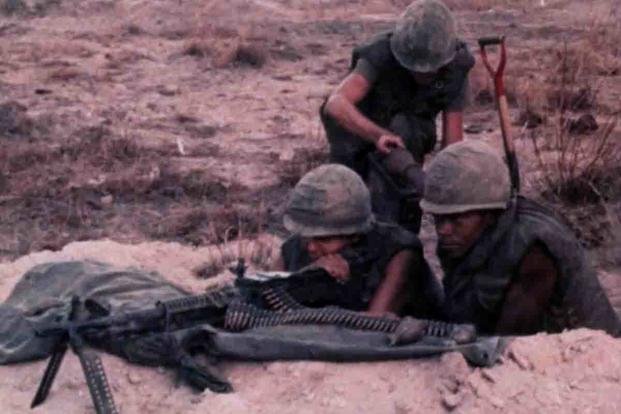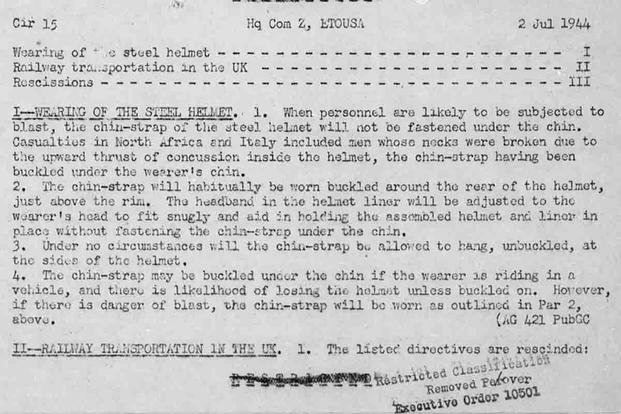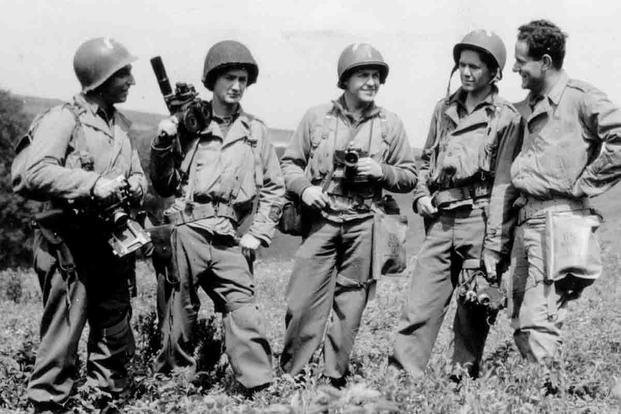You have to admit, troops from World War II, Korea and Vietnam looked pretty cool in those old photos. Our loved ones in combat zones, carrying their weapons on their shoulders and wearing their helmet with the chin strap hanging off the side looked pretty badass.
While it may look cool in movies, any modern-day soldier, sailor, airman or Marine knows that look just doesn't fly today. U.S. troops learn this very quickly in basic training. Trying to wear a brain bucket like their grandpa used to will only ensure they're swarmed by Smokey Bear hats who want to loudly remind them they aren't John Wayne.
Your grandpa and his awesome-looking battle buddies didn't wear their chin straps because they were afraid it might snap their necks. You don't wear the same helmet, yours is much lighter and, also, you know better. Basic training made sure of that.
The iconic helmet worn by veterans of generations past is the M1. It was first developed and mass-produced in 1941, before the United States entered World War II and was the standard helmet all the way through the mid-1980s. More than 22 million were made during World War II alone.
It might have slid down over their eyes while prone, but it could be used to make coffee, was an excellent shovel in a pinch and did a pretty good job of keeping flying Nazi bullets out of their brain. It's no wonder the U.S. government kept them in service for so long.

So those unclasped chin straps dangling from helmets look so cool in both World War II and Vietnam, because they were the same helmet. John Wayne could have worn one in a movie about either war. Wayne, of course, didn't wear any helmet to any war. But keep in mind: You are not John Wayne.
Also Read: Why John Wayne Was Labeled a 'Draft Dodger' During World War II
In World War II, the United States wasn't fielding a professional, all-volunteer army. The soldiers who fought in North Africa, Europe and the Far East were largely drafted. Since the U.S. was also not the well-developed and well-connected country we know it as today, these conscripts were experiencing a lot for the very first time.
Since operational security was also paramount during the war, they weren't told a lot about what they were doing or why: They knew what they needed to know. Because they were all deployed American troops, the gaps in their knowledge were filled with -- you guessed it -- rumors.
The rumor mill was hard at work in World War II, because information was hard to get, enemy disinformation was rampant and sometimes they didn't know better. Rumors spread about women in Army service being property of Army officers and those officers could have their way with them, that no ships survived Pearl Harbor or that Japanese troops were mailing the eyes of the dead back to American homes. None of that was true.
Your grandpa wasn't unstrapping his helmet to look cool. He and other GIs heard that strapping their chins to their manganese-steel M1 helmet would make their head pop back and their neck snap amid artillery bursts or close, upward explosions. They thought the force combined with the weight of the helmet was enough to pop them right off.
In some cases, commands even made it an order.

If you didn't know any better, you'd probably unstrap your chin strap, too. And so would your military training instructor (MTI), drill sergeant, drill instructor or whatever the Navy calls their Smokey Bear hat guys. You might notice that even the above command says not to let the chin strap hang on the sides of the helmet --so maybe there was a little bit of coolness factor involved.
It was, of course, just a rumor. The M1 helmet did a pretty good job of keeping many heads safe, even when exposed to artillery, explosions or small arms fire. They didn't have a 100% safety record, but what U.S. military-issued equipment does?

American troops finally got a break from the longtime heavyweight standard-bearer of helmets in the late 1980s, when they were replaced with modern, lighter-weight kevlar ones. The new Personnel Armor System for Ground Troops (or PASGT) arrived in time to make an appearance in the U.S. invasion of Grenada and phased out the good ol' M1 in time for Operation Desert Storm.
In 2003, the standard-issue helmet was again upgraded to the Advanced Combat Helmet (ACH), which offered improved coverage, ballistic protection and a much lighter weight of about 2.4 pounds that would not snap a troop's neck in an explosion.
Even though the helmet technology is obsolete, your grandpa and his buddies did look really cool, even if they were really just afraid of breaking their necks. It virtually guarantees that future generations of veterans in basic training will still try to get away with unstrapping their helmets.
-- Blake Stilwell can be reached at blake.stilwell@military.com. He can also be found on Twitter @blakestilwell or on Facebook.
Want to Learn More About Military Life?
Whether you're thinking of joining the military, looking for post-military careers or keeping up with military life and benefits, Military.com has you covered. Subscribe to Military.com to have military news, updates and resources delivered directly to your inbox.
















